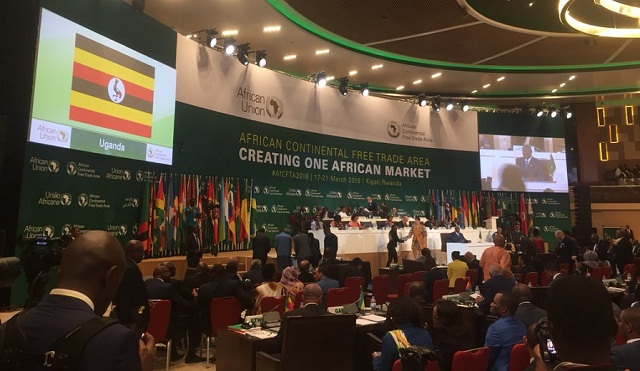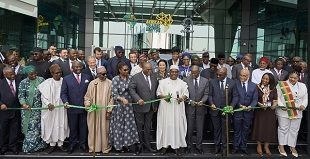
The launch of the CFTA was a major milestone for Africa; a clear message to the rest of the world
COMMENT | FRANCIS MANGENI | When African leaders launched the massive Continental Free Trade Area (CFTA) on March 21, 2018, at a summit in Kigali, Rwanda, their top priority should have been to avoid rolling out something that is either hollow or redundant. The CFTA – one of 12 flagship programs under the African Union’s (AU) Agenda 2063 framework – could double intra-African trade and bring enormous benefits to the continent. But much will depend on the arrangement’s final shape.
One positive sign is that the CFTA will include trade in services, which already contribute more than 50% of African countries’ GDPs, on average. A growing body of research suggests that services will provide new social- and economic-development pathways for Africa. In their recent book `The Unexplored Potential of Trade in Services in Africa’, Nora Dihel and Arti Grover Goswani of the World Bank marshal data to show that services have the potential to provide much-needed employment and incomes for ordinary people across the continent.
Service industries such as communications, transportation, banking, insurance, energy, education, and health are key drivers of development, while both tourism and construction currently have high growth potential. Moreover, for many young professionals, services are the only way to earn a living. And with the emergence of entrepreneurial universities – where course work and dissertations produce business propositions rather than just paper degrees – vibrant services markets will become more necessary than ever.
But Dihel and Goswani also warn of “regulatory hurdles.” African policymakers will need to go beyond the initial framework that has already been agreed under the CFTA, to identify sectors that can be brought into the fold of a wider, integrated services market. And a comprehensive framework to establish the terms and conditions of trade and investment in specific sectors, and to attract investment, should follow.
In selecting sectors to promote, the focus should be on infrastructure and areas where countries have already made market-access commitments through the World Trade Organisation. That implies that policymakers should concentrate on communications, tourism, banking, transport, and energy, followed by education, health, and construction services. One positive development came earlier this year with the establishment of the AU’s Single African Air Transport Market, which covers 23 countries and 70% of air travel in Africa.
As for trade in goods, the main goal of the CFTA is to open up markets through a broad reduction in tariffs. But before that can happen, African countries need to agree on a common schedule for lowering their import barriers. That will require potentially complex negotiations among multiple stakeholders. To simplify matters, it will be important to keep the number of negotiating parties to a minimum, perhaps by forming country groupings. Beyond that, a fairly short timeframe for negotiations should be established, so that talks do not bog down.
Beyond across-the-board tariff reductions, policymakers will also need to designate sensitive and excluded products in a way that promotes regional value chains, including in agro-processing, chemicals, and automobiles, as well as in the services/logistics inputs that constitute up to 60% of the value of final products. Policymakers should also impose a cap on the maximum value of imports that can be excluded. On the whole, African trade already comprises relatively few product lines, which means that if the most-traded products are excluded, intra-African trade will suffer, and the entire CFTA will be rendered redundant.
Although trade under the CFTA regime will not begin until there are established rules of origin, participants have at least agreed to follow the World Customs Organisation’s recognised criteria for determining “value addition,” “material content,” “substantial transformation,” and whether goods are “wholly obtained.”
Still, producing product-specific rules for 6,000-odd goods can take a very long time (it has taken the WTO over 27 years). To expedite the CFTA, African countries could agree to a general minimum threshold of 20-40% for value addition and a maximum of 60-80% for non-originating material. And in the meantime, work on determining substantial transformation and other product-specific rules could continue, albeit with a set timeframe.
A critical objective in setting the CFTA’s product-specific rules of origin should be to promote the production and trade of inputs and other intermediate products within Africa. The CFTA should enshrine the principle of “Made in Africa,” even as it recognises that some inputs will necessarily be sourced from abroad.
It was everyone’s hope that African heads of state turn up in large numbers to the AU Kigali summit this March. The launch of the CFTA was a major milestone for Africa. It will permanently change the continent’s economic geography and defining narrative. African leaders used the occasion to send a clear message to the rest of the world that Africa is ready for a social and economic transformation.
*****
Francis Mangeni is Director of Trade, Customs, and Monetary Affairs at the Common Market for Eastern and Southern Africa (COMESA).
Copyright: Project Syndicate, 2018.
 The Independent Uganda: You get the Truth we Pay the Price
The Independent Uganda: You get the Truth we Pay the Price



